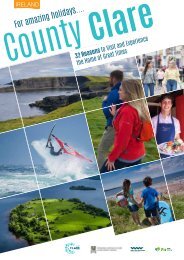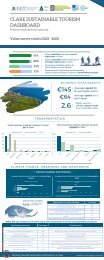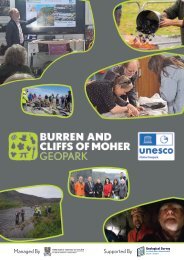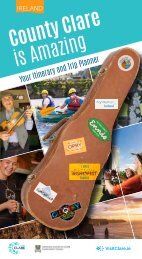Burren and Cliffs of Moher UNESCO Global Geopark - Geology
A collection of articles about the geology in the Burren and Cliffs of Moher UNESCO Global Geopark written by Dr Eamon Doyle - Geopark Geologist
A collection of articles about the geology in the Burren and Cliffs of Moher UNESCO Global Geopark written by Dr Eamon Doyle - Geopark Geologist
You also want an ePaper? Increase the reach of your titles
YUMPU automatically turns print PDFs into web optimized ePapers that Google loves.
Fossil crinoids – finding the ‘new’ in<br />
the old<br />
The limestone <strong>of</strong> the <strong>Burren</strong> is packed with fossils. It is<br />
reasonable to say it is made <strong>of</strong> fossils. A lot <strong>of</strong> the time<br />
we don’t see them because the surface <strong>of</strong> the limestone<br />
is covered by algae or lichen but just below the surface<br />
lie the remains <strong>of</strong> animals that lived in a tropical shallow<br />
sea, 330 million years ago. And <strong>of</strong> all the fossils in the<br />
limestone, bits <strong>of</strong> fossil crinoids are the most abundant.<br />
Crinoids come in a variety <strong>of</strong> forms, the most typical<br />
being a long narrow stem, with a globular body or ‘calyx’<br />
on top <strong>and</strong> multiple long feathery-looking arms extending<br />
upwards from that. They look a bit like ferns <strong>and</strong> are<br />
also known as ‘sea-lilies’ or ‘feather stars’. Crinoids were<br />
abundant in the Carboniferous shallow seas <strong>and</strong> they are<br />
still found in the world’s oceans today although generally<br />
in deeper water, so they are rarely seen. Crinoids belong<br />
to the echinoderms, so they are closely related to sea<br />
urchins, s<strong>and</strong> dollars, starfish <strong>and</strong> even sea cucumbers.<br />
Like many sea creatures, crinoids make their hard parts<br />
out <strong>of</strong> the mineral calcite. It is the hard parts that survive<br />
to become fossils. For crinoids, their hard parts are a<br />
series <strong>of</strong> discs stacked on top <strong>of</strong> each other that make up<br />
the skeleton <strong>of</strong> the stem <strong>and</strong> arms <strong>of</strong> the animal. During<br />
life, these are attached together by ligaments giving the<br />
animal a degree <strong>of</strong> flexibility to wave around in ocean<br />
currents, where they use their arms to collect food from<br />
the water.<br />
Unfortunately, most fossil crinoids in the <strong>Burren</strong><br />
limestone are not complete, they were separated into<br />
their individual pieces shortly after they died, when the<br />
connecting tissues had decomposed or were eaten. These<br />
pieces <strong>of</strong> crinoid were then moved around on the seafloor<br />
by waves <strong>and</strong> currents <strong>and</strong> broken up even further by<br />
burrowing organisms or scavengers before being buried<br />
<strong>and</strong> turned to rock. These individual circular sections <strong>of</strong><br />
stem are known as ‘ossicles’ <strong>and</strong> vary in size from 1mm<br />
to about 20mm in diameter. When alive, the stems can<br />
be over 1m long but after death they break up, however,<br />
sometimes short sections <strong>of</strong> stem survive intact. While<br />
finding a complete fossil crinoid in the <strong>Burren</strong> is unlikely,<br />
because each crinoid has hundreds <strong>of</strong> individual pieces,<br />
this means there are a lot <strong>of</strong> crinoid pieces to be found.<br />
When palaeontologists find ‘new’ species, they are <strong>of</strong><br />
course finding old fossils <strong>and</strong> just giving them a new<br />
name. My <strong>Geopark</strong> research with Dr. Steve Donovan on<br />
fossil crinoids has already identified a ‘new’ 326 million<br />
year old species (Heloambocolumnus harperi) from<br />
Doolin, a crinoid unknown anywhere else in the world.<br />
As I find more specimens, this ‘new’ material should<br />
provide even more ‘new’ fossil discoveries in the coming<br />
years.<br />
Figure caption: Fossil crinoids from the <strong>Burren</strong>. Left, fossil crinoid ossicle unique to Doolin; centre, typical preservation <strong>of</strong> crinoid bits; right,<br />
short section <strong>of</strong> intact stem.


















